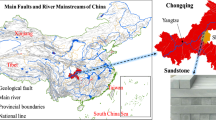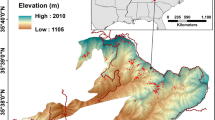Abstract
The McAuley Creek Landslide is a 6 million m3 gneissic rock slope failure that occurred in British Columbia (Canada) in late May–early June 2002. The geological strength index was used to characterize the quality of the overall rock mass and its reduced (damaged) quality near tectonic structures and alteration zones. Potential slope failure mechanisms were investigated using four analysis techniques including: kinematic analysis, surface wedge limit equilibrium (combination) analysis, block theory and three-dimensional distinct element models. Results from all four analyses suggested that the dominant slope failure mechanism was wedge sliding along the intersection of the gneissic foliation and a steeply dipping discontinuity set striking perpendicular to the slope. Of the 6 million m3 of material involved in the landslide, an estimated 5 million m3 was deposited immediately below the source area against the opposite valley wall, with the remaining 1 million m3 travelling an additional 1.6 km downstream. The runout behaviour was investigated using a three-dimensional dynamic analysis code.
Résumé
Le glissement de terrain de McAuley Creek est un glissement rocheux de 6 millions de m3 dans des roches gneissiques qui eut lieu en Colombie-Britannique (Canada) en fin mai-début juin 2002. L’indice GSI (Geological Strength Index) a été utilisé pour caractériser la qualité d’ensemble de la masse rocheuse et la qualité réduite à proximité de structures tectonisées et de zones altérées. Des mécanismes de rupture potentielle ont été étudiés à partir d’une analyse cinématique de stabilité, une analyse de stabilité de dièdres suivant la théorie des équilibres limites, des modélisations basées sur la théorie des blocs et sur la méthode tridimensionnelle des éléments distincts. Les quatre méthodes ont conduit à la conclusion que le mécanisme principal contrôlant la rupture a été un glissement de dièdre le long de la ligne d’intersection des surfaces de foliation des gneiss avec une famille directionnelle de discontinuités orientée perpendiculairement à la pente. Parmi les 6 millions de m3 de matériaux concernés par le glissement de terrain, un volume estimé à 5 millions de m3 s’est déposé immédiatement au pied de la zone source contre le versant opposé de la vallée, le volume restant, de 1 million de m3, se déplaçant sur une distance supplémentaire de 1,6 km vers l’aval. Le comportement des matériaux durant cette phase de transport a été étudié à partir d’un code d’analyse dynamique tridimensionnelle.


























Similar content being viewed by others
References
ASTM (2006) Standard test method for determination of the point load strength index of rock. Annual Book of ASTM Standards. Volume 4 Construction. American Society for Testing and Materials, D 5731-05
Ayotte D, Hungr O (2000) Calibration of a runout prediction model for debris-flows and avalanches. In: Wieczorek N (ed) Debris-flow hazards mitigation: mechanics, prediction, and assessment, pp 505–514
BC Ministry of Forests and Range (2009) Meteorological data from BC Ministry of Forests and Ranges. Unpublished data obtained October 20, 2009
Blyth Consulting (2002) Harris creek south—terrain stability map. Map prepared for Riverside Forest Products Limited (Lumby Division). Scale 1:20,000. Map sheet references: 82L.006, 82L.007, 82L.016, 82L.017
Brideau M-A, Yan M, Stead D (2009) The role of tectonic damage and brittle rock fracture in the development of large rock slope failures. Geomorphology 103(1):30–49
Brideau M-A, Stead D, McDougall S, Couture R, Evans SG, Turner K (2010) 3D numerical modeling of the failure mechanism and runout at the 2002 McAuley Creek Landslide, British Columbia, Canada. In: Williams AL, Pinches GM, Chin CY, McMorran TJ, Massey CI (eds) 11th International Association of Engineering Geology and Environment Congress. CRC Press, Auckland, pp 53–62
Brown ET (2008) Estimating the mechanical properties of rock masses. In: Potvin Y, Carter J, Dyskin AV, Jeffrey R (eds), Southern hemisphere international rock mechanics symposium, Perth, pp 3–22
Environment Canada (2009) http://climate.weatheroffice.gc.ca. Accessed October 18, 2009
Evans SG, Couture R, Turner K, Fuller T (2003) The 2002 Rock avalanche at McAuley Creek, near Vernon, British Columbia; Implications for regional landslide hazard assessment, In: 3rd Canadian conference on geotechnique and natural hazards, Edmonton, p 299
Evans SG, Tutubalina OV, Drobyshev VN, Chernomorets SS, McDougall S, Petrakov DA, Hungr O (2009) Catastrophic detachment and high-velocity long-runout flow of Kolka Glacier, Caucasus Mountains, Russia in 2002. Geomorphology 105:314–321
Geoterrain Consultants Foxview Management Limited (Roed, MA) (1998) Harris creek watershed—detailed terrain and terrain stability map. Map prepared for Riverside Forest Products Limited. Scale 1:20,000. Map sheet reference: 82L.016
Glombick P, Thompson RI (2004) Geology Creighton Creek, British Columbia. 1:50 000 Map. Geological Survey of Canada Open File 4371
Golden (2002) Surfer version 8. Golden Software Inc. Golden, Colorado
Goodman RE, Shi G-H (1985) Block theory and its application to rock engineering. Prentice Hall
Hoek E, Brown ET (1997) Practical estimates of rock mass strength. Int J Rock Mech Miner Sci 34(8):1165–1186
Hoek E, Kaiser PK, Bawden WF (1995) Strength of rock and rock masses, Chap 8. In: Support of underground excavations in hard rock. Balkema, Rotterdam, pp 84–98
Hsu KJ (1975) Catastrophic debris streams (sturzstroms) generated by rockfalls. Geol Soc Am Bull 86:129–140
Hungr O (1995) A model for the runout analysis of rapid flow slides, debris flows, and avalanches. Can Geotech J 32:610–623
Hungr O, Evans SG (1996) Rock avalanche runout prediction using a dynamic model. In: Senneset K (ed) 7th international symposium on landslides. Balkema, Rotterdam, pp 233–238
Hungr O, McDougall S (2009) Two numerical models for landslide dynamic analysis. Comput Geosci 35:978–992
ISRM (1978) Suggested methods for the quantitative description of discontinuities in rock masses. Int J Rock Mech Min Sci Geomech Abstr 15:319–368
ISRM (1985) Suggested method for determining point load strength. Int J Rock Mech Min Sci Geomech Abstr 22:51–60
Itasca (2008) 3DEC v. 4.1. Itasca Consulting Group, Minneapolis
Kulhawy FH (1975) Stress deformation properties of rock and rock discontinuities. Eng Geol 9:327–350
Marinos P, Hoek E (2000) GSI: a geologically friendly tool for rock mass strength estimation, In: GEOENG 2000, Melbourne, pp 1422–1442
Marinos V, Marinos P, Hoek E (2005) The geological strength index: applications and limitations. Bull Eng Geol Environ 64:55–65
Mauldon M (1998) Estimating the fracture trace length and density from observations in a convex window. Rock Mech Rock Eng 31(4):201–216
McDougall S, Hungr O (2004) A model for the analysis of rapid landslide motion across three-dimensional terrain. Can Geotech J 41(12):1084–1097
McDougall S, Boultbee N, Hungr O, Stead D, Schwab J (2006) The Zymoetz River Landslide, British Columbia, Canada: Description and dynamic analysis of a rock slide—debris flow. Landslides 3(3):195–204
National Earthquake Database (2009) http://earthquakescanada.nrcan.gc.ca/. Accessed October 18, 2009
Pantechnica (2002) Kbslope, Pantechnica Corporation, Chaska Minnesota
Priest SD (1993) Discontinuity analysis for rock engineering. Chapman and Hall, London
Revellino P, Hungr O, Guadagno FM, Evans SG (2004) Velocity and runout simulation of destructive debris flows and debris avalanches in pyroclastic deposits, Campania Region, Italy. Environ Geol 45:295–311
Richards L, Leg G, Whittle R (1978) Appraisal of stability conditions in rock slopes. In: Bell F (ed) Foundation engineering in difficult ground. Newnes-Butterworths, London, pp 449–512
Rocscience (2008) Swedge version 5.005. Rocscience Inc., Toronto
Ryder JM (1991) Quaternary geomorphology and terrain map of the Harris Creek area, British Columbia (part of NTS 82L/1, 2) BC Ministry of Energy, Mines and Petroleum Resources. 1:20 000 maps, Open File 1991-18
Strouth A, Eberhardt E (2009) Integrated back and forward analysis of rock slope stability and rockslide runout at Afternoon Creek, Washington. Can Geotech J 46:1116–1132
Sturzenegger M, Stead D, Beveridge A, Lee S, Van As A (2009) Long-range terrestrial digital photogrammetry for discontinuity characterization at Palabora open-pit mine. In: Diederichs MS, Grasselli G (eds) Third Canada–US rock mechanics symposium, Toronto. Paper 3984
Willenberg H, Eberhardt E, Loew S, McDougall S, Hungr O (2009) Hazard assessment and runout analysis for an unstable rock slope above an industrial site in the Riviera valley, Switzerland. Landslides 6:111–119
Zhang L, Einstein HH (1998) Estimating the mean trace length of rock discontinuities. Rock Mech Rock Eng 31(4):217–235
Author information
Authors and Affiliations
Corresponding author
Rights and permissions
About this article
Cite this article
Brideau, MA., McDougall, S., Stead, D. et al. Three-dimensional distinct element modelling and dynamic runout analysis of a landslide in gneissic rock, British Columbia, Canada. Bull Eng Geol Environ 71, 467–486 (2012). https://doi.org/10.1007/s10064-012-0417-8
Received:
Accepted:
Published:
Issue Date:
DOI: https://doi.org/10.1007/s10064-012-0417-8




